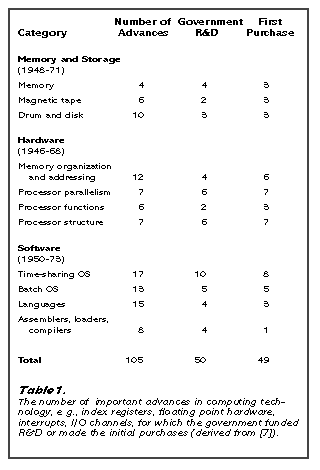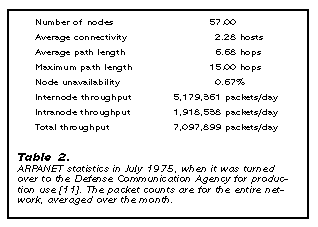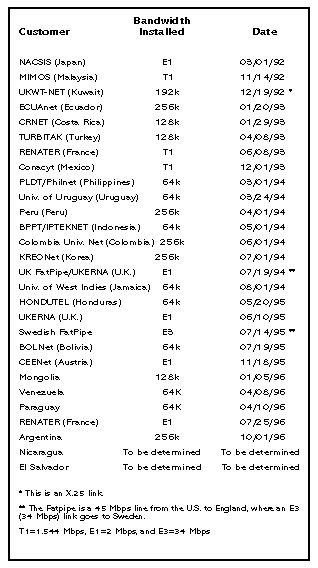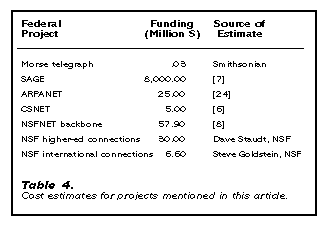 |
|
|
 Seeding Networks: The Federal Role Seeding Networks: The Federal RoleBy Larry Press lpress@isi.edu Many federal agencies have contributed to the development of networking, but the work of ARPA, the Advanced Research Projects Agency of the Department of Defense (DOD), and the NSF, the National Science Foundation, stands out. The ARPANET established the feasibility of an efficient packet-switching network-a controversial idea at the time-and provided a technology development test bed. When it became clear that the network was a valuable asset for ARPA research contractors, NSF broadened participation with CSNET, a network connecting university and nonuniversity computer scientists. CSNET was followed by NSFNET, which connected a much wider community of users. There has been significant return to the organizations that participated in this work, and a much greater return to the society. This article looks at those networks and their costs and benefits, but first let's look at some government-sponsored prehistory. Before the ARPANET Governments and the military have been interested in telecommunication since ancient times, but two optical networks were particularly influential. The French government built a network of semaphore towers designed by Claude Chappe in 1793, and in 1794 the British Admiralty began a network using George Murray's towers on which six shutters, or bits, could be open or closed. Chappe's network operated until 1853, eventually reaching Holland and Italy. A measurement in 1819 showed transmission time of 1,710 seconds over 224 stations from Lyons to Paris, but that was very fast. Station logbooks typically recorded two or three symbols per minute (Holzmann and Pehrson). The U.S. Congress was considering a petition to authorize a New York–New Orleans Chappe line when Samuel F. B. Morse first argued for government support of his electromagnetic system. Morse patented his telegraph in 1837, demonstrated it to the government and others in 1838, and received a $30,000 congressional appropriation in early 1843. The 37-mile link from Washington to Baltimore was inaugurated in 1844 with the famous message "What hath God wrought?" Morse used the seed money well. New York and Boston were online by 1845, and licensees spread throughout the United States and Canada. Private operators began merging to facilitate message interchange, beginning on a grand scale with the formation of the Mississippi Valley Printing Telegraph Company in 1851, which, in 1856, was renamed the Western Union Telegraph Company. As with the Internet, the government started the ball rolling, and rapid capitalization and growth followed in the private sector. Governments also provided funding and leadership for computing technology, from Babbage to the ENIAC and most of the experimental computers which followed it.1 When it was time to begin commercial development, government orders underwrote machines from innovative start-ups like Engineering Research Associates and well-established companies like IBM. IBM's first commercial computer, the 701, was initially called the Defense Calculator. Marketing research for the 701 consisted of visits to 22 government agencies (Birkenstock), and at least 18 of the 19 701s were involved in defense work (Hurd). As seen in table 1 below, many early computing advances were made by government- funded R&D, were initially purchased by the government, or both.
The government also bootstrapped computer communication with Whirlwind, an Office of Naval Research computer that processed telemetry data in real time at Massachusetts Institute of Technology. Whirlwind demonstrated the feasibility of real-time data communication over analog telephone lines and led to important engineering developments like core memory. After the Whirlwind R&D, the government turned to procurement with SAGE (Semi-Automatic Ground Environment), a system that defends against manned bomber attacks. Whirlwind's successor, the XD-1, was the prototype for the IBM AN/FSQ-7 and AN/FSQ-8 (Army-Navy Fixed Special eQipment) computers, which were used in SAGE. SAGE was the first computer network, growing finally to link Q-7s and Q-8s in 26 centers. SAGE cost estimates range from $4 billion to 12 billion, with $8 billion a common estimate. Included were 56 IBM computers at $30 million each, 25,000 telephone lines, and the employing and training of roughly 3,000 programmers at System Development Corporation (SDC), a RAND spin-off that developed the SAGE software and installed the system. (Baum, Flamm). ARPA SAGE was a special-purpose network, but general-purpose networking got rolling with ARPA's leadership and funding. The goals of ARPA's Resource Sharing Computer Network project were to develop the technology for and demonstrate the feasibility of a computer network while improving communication and collaboration between research centers by means of grants from ARPA's Information Processing Techniques Office (IPTO).2 Early papers on the ARPANET (Marill and Roberts, Roberts and Wessler), speak of file transfer and remote login as concrete goals, allowing users to share programs, data, and powerful hardware from a distance. But the vision went beyond those technical facilities. The vision grew out of the collaborative communities that formed around the early time-sharing systems. Although most computing in the 1950s was done in batch mode, anyone who had performed interactive computing knew the latter was far superior, but expensive. The case for interactive computing was stated by MIT's J. C. R. Licklider in an influential paper on man-machine symbiosis (Licklider). As the first IPTO director-from 1962 to 1964- Licklider set about implementing his vision with funding for early time-sharing Systems: affordable interactive computing. ARPA funded 6 of the first 12 general-purpose time-sharing systems, including two influential systems: CTSS at MIT and the AN/FSQ-32 at SDC (Flamm, p. 26). It was clear that these systems could be used from a distance and, more important, that they fostered collaborative user communities. (I used the Q-32 for my dissertation and can personally testify to the excellence of the development environment and the spirit of sharing and collaboration it fostered among users.) Licklider outlined his vision of computers as communication and collaboration-support devices in another widely read paper (Licklider and Taylor) and laid the groundwork for the funding of the ARPANET by his successors at IPTO: Larry Roberts, Ivan Sutherland, and Robert Taylor. In addition to MIT and SDC, Licklider funded Doug Engelbart's pioneering work on interactive and collaborative computing at Stanford Research Institute (Press). It was not clear at the start that packet switching was the way to go, but studies by Paul Baran at RAND, Donald Davies at England's National Physical Labs, and Leonard Kleinrock at MIT were encouraging. In 1965 a link was tested between SDC and MIT (Marill and Roberts), and preliminary design and "selling" to IPTO research sites was conducted during the next few years. In 1968 bids were solicited and awards made, and work started in 1969 (Heart et al.). Several organizations shared in the ARPANET award. Bolt, Beranek, and Newman (BBN), where Licklider had also worked, won for system design and integration, and they subcontracted the communication computers to Honeywell. UCLA did network measurement. Stanford Research Institute ran the network information center. AT&T and others provided communication links. And Network Analysis Corporation designed the topology. This was a joint industry-university-government project, with IPTO remaining active in oversight and management. The ARPANET architecture called for specialized network communication computers called interface message processors (IMPs). Each IMP was to connect from one to four hosts and be linked to three to five other IMPs. The original message format specification had only a 6-bit address, limiting the network to 64 IMPs. IMPs performed communication tasks like routing, error checking, flow control, and network management. The hosts were heterogeneous time-sharing systems-isolated from their IMPs by well-defined electrical and software interfaces. TIPs-terminal IMPs-were later designed to connect terminals to the Net without the need for an intermediate host. A TIP consisted of a minihost plus an IMP. The first IMP was booted up at the University of California, Los Angeles, in 1969, and it was quickly linked to three others at UC Santa Barbara, the University of Utah, and Stanford Research Institute. The Net grew like a weed. International links to England and Norway were set up in 1973. (Norway was chosen for military purposes: a North Atlantic Treaty Organization member near the Soviet Union.) When the ARPANET was turned over to the Defense Communication Agency for production work-and cloning-in 1975, there were 57 nodes (table 2).
The ARPANET was widely publicized in papers, a short documentary, and a major public demonstration in 1972, and the word got out. As with time-sharing before it, anyone who tried the Net understood its value. (My eyes were opened during a joint-authoring exercise in which I collaborated with people around the United States by using a Teletype with an acoustical coupler in my den at home.) It was clear to academic researchers that their counterparts at centers with ARPANET connectivity had an advantage, and they wanted the same. NSF In 1974 the NSF Computer Science and Engineering Advisory Panel recommended that "the NSF provide to qualified computing researchers easy access to an international computer network. This access would create a frontier environment which would offer enhanced communication, collaboration, and the sharing of resources among geographically separated or isolated researchers" (Comer). NSF funded THEORYNET, a central e-mail computer at the University of Wisconsin, where roughly 100 theoretical computer scientists dialed in using modems or X.25 and exchanged e-mail, and there were scattered UUCP efforts, but relatively few computer scientists were networked. THEORYNET organizer Larry Landweber convened an NSF-sponsored meeting in 1979 to plan connectivity for all computer scientists. The result, after two major review and revision cycles, was the establishment of CSNET in 1981 (Comer). CSNET was seeded with a $5-million grant from the NSF, which also managed the project for two years, before turning it over to BBN. It provided e-mail (Phonenet) service for small institutions, TCP/IP connectivity over X.25 or the ARPANET for larger institutions, and a name server. The mail software was provided by the University of Delaware, and TCP/IP, which had become a DOD standard, came from ARPA. CSNET was arguably the first Internet service provider (ISP). The charter called for financial independence after five years, and member institutions paid either $30,000 (industrial), $10,000 (government or nonprofit) or $5,000 (university) per year. The fee was later reduced for small computer science departments. CSNET was self-sufficient under BBN and by 1985 had more than 165 member institutions-most of them academic-in the United States and abroad. CSNET, along with Bitnet, was eventually transferred to the Corporation for Research and Educational Networking. By the mid-1980s, the value of networks was abundantly clear, and many discipline-specific, state and regional, corporate, and campus networks were operating (Jennings et al., Quarterman and Hoskins). It was time to link these efforts and move networking from computer science to the entire university and research community, then to the commercial sector. Again, the NSF provided seed funding and leadership in the creation of NSFNET (Frazer). In 1984 an NSF panel suggested a two-stage approach: first to link the NSF supercomputer centers and then to construct a high-speed backbone network for connecting existing and future regional, campus, and other networks. In 1985 six federally funded supercomputer centers were linked in a 56 Kbps network, and in 1987 bids were solicited on the NSFNET backbone. Merit Network, which had experience linking four universities in Michigan, was selected along with partners IBM, MCI and the state of Michigan. By 1988 13 backbone nodes linked supercomputer centers and regional networks in a 1.544 Mbps network, which was later upgraded to 45 Mbps. When decommissioned in April 1995, NSFNET was the global backbone, linking 28,470 domestic and 22,296 foreign networks. The NSF also helped non–computer scientists to connect. The purpose of NSF's 1990 Higher Education Connection solicitation was to encourage the networking of U.S. academic institutions that had research or undergraduate education missions. Dave Staudt, NSF associate program director, estimates that approximately 1,300 of the roughly 3,600 four-year colleges and universities in the United States have been assisted at a cost of about $30 million. Today institutions of higher education, including technical and community colleges, can apply for $20,000 each for connection assistance. This represents only a small portion the total cost, because individual schools must themselves provide access for all qualified faculty and students. In addition to connectivity grants for higher education, NSF supports research-oriented connection to its new high-speed backbone and connections for innovative applications of networking in selected K–12 schools. According to the U.S. Department of Education, about half of U.S. public schools are linked to the Internet, though only 9 percent of classrooms are (Newstrack). NSF has directly supported only a few of these, but many connect to universities and ISPs that have had NSF support. The U.S. scientific community collaborates with international researchers and educators, and the NSF has played a key international role. In 1990 a solicitation called for assistance in connecting international scientists and educators to NSFNET, beginning with the French and Scandinavian research networks (Goldstein). Sprint was the successful bidder, and with the active collaboration of NSF Program Director Steve Goldstein, Sprint has helped link 28 research and education networks of 26 nations to NSF-sponsored ports in the United States (table 3). Note that even though the initial solicitation was for Europe, much of the effort has been directed at developing nations. The NSF has assisted Latin American, Asian, and African networks with U.S. connection points, communication links, and consultation. For example, the NSF recently helped Mongolia with a port and subsidy for a satellite link; the rest of the funds came from Mongolia and a fund resulting from the sale of surplus butter there. This program has been indefatigable and instrumental in bringing the Net to nations it would otherwise not reach.
Was It Worth It? Without SAGE the projects mentioned in this article have cost less than $127 million (table 4), and the benefits have been immense. There are three benefit classes: direct and subsequent payoff to organizations doing the R&D and return to the rest of society.
Direct payment for R&D may represent a substantial portion of an organization's gross revenue. For example, SDC was formed to build SAGE, which would not have existed without it. However, this business is not highly profitable. IBM grossed $500 million on SAGE computers and 7,000–8,000 of its 39,000 employees worked on SAGE during 1955, but profit levels were lower than those of the firm's regular business (Flamm, pp. 88–89). Hall states, "Since 1972, microeconomic studies have repeatedly demonstrated that federally funded R&D generates a direct return of zero for the firms that do it." When an R&D project is finished, contractors and vendors may reap further profits based on their experience. For example, the BBN group used its ARPANET experience to start the X.25 Telenet network, which grew rapidly and was sold to GTE at a substantial profit, and its follow-on work operating the Defense Data Network was responsible for roughly 10 percent of its income for five years (McKenzie). IBM's SAGE experience contributed to BBN's work on American Airlines' SABRE reservation system, which gave the group an early lead in commercial online systems. SAGE produced technical innovations like cycle-stealing DMA and the use of printed circuits in production machines. In addition, SAGE-based core memories were used in the 701 (early 701s used CRT memory and were retrofitted). MCI gained knowledge and contacts from BBN's NSF work. And the group's Internet business now totals $100 million a year and is projected to top $2 billion by the year 2000 (Cerf). Mansfield finds a median return of 25 percent on innovations derived from R&D in a study of 17 industries. The greatest payoff on R&D is social return-return to organizations that do not participate directly. Social return provides the rationale for government support, because from the societal perspective, self-serving organizations that are under short-term pressure to show profit sometimes underinvest in risky R&D. Where would we be if we had left agricultural research to farmers instead of land-grant universities? Mansfield cites studies showing median social returns of 70, 56, and 99 percent on innovations.3 The payoff has been much greater for the R&D discussed here. Entire industries, such as LANs, routers, and ISPs, have resulted from this work. Boardwatch magazine (http://www.boardwatch.com) lists 2,272 U.S. ISPs in its directory, and the recruiting firm Christian and Timbers estimates that 40,000 people hold jobs directly related to the Internet, 36,000 jobs became available at Internet-related companies in 1995, and 100,000 will have been created in 1996 (Newstrack). Perhaps the key payoff has been in the form of enhanced human capital-both technicians and users. Although it may be argued that SAGE was obsolete and unworkable from the start, it was a significant national training resource. SDC trained thousands of programmers, systems analysts, and systems training experts. In July 1954, all of the computer manufacturers together provided 2,500 student-weeks of programmer instruction; three years later SDC was providing 10,000 student-weeks. By 1959 there were 800 SAGE programmers; by 1963 SDC had 4,300 employees, and 6,000 former employees were in industry (Baum). Many of today's Internet executives trace their training to the ARPA and NSF projects. Comer learned the TCP/IP protocols on the CSNET project, and his textbooks have trained a generation of networking specialists. Trained, demanding end users are an even more important resource than networking technicians. As an example of the impact of the NSF connections programs, consider the small university where I teach. We received $10,000 for a router and some subsidy for communication links and ports from NSF. This precipitated our connection to the Net and motivated intracampus connectivity. Faculty from literally every discipline use the Net for teaching and research, and 4,884 of our 9,828 resident students have accounts. E-mail and the Web are routinely used in classes. We have both an external humanities program with more than 2,000 students and a statewide nursing program with 1,883 students. And we teach Webmaster courses. The Net is the hottest technology to hit our campus since blackboards were installed, and, as the NSF intended, it has gone well beyond computer scientists. Upon graduatingour students-and their counterparts around the nation-bring their Net skills and expectations with them to industry.
Those interested in the history of networking or computing-related
topics should check out the excellent journal Annals of the History of Computing. "subscribe cpsr-history <your name>" to listserv@cpsr.org Two Internet time lines on the Web: one and two. One does not typically make association between the expressions government program and immense return, but these programs were not being conducted by the post office or a department of motor vehicles. Several characteristics distinguish them: - These are short-term projects, not ongoing programs. Would a U.S. Department of Programmer Training project have done as good a job as SDC's SAGE trainers? I doubt it, and had it been established, it would doubtless still be with us-though one can surely think of alternative uses for $8 billion. - The NSF programs provided only seed funding-a small fraction of the cost to the participating institutions that had to be highly committed themselves. - These were focused projects, with concrete goals. Even though it was far from clear that those goals were achievable, though much new technology still had to be invented, and though there were unexpected benefits, these were more development than research projects. - The projects provided leadership. The visions of Licklider and others associated with the ARPA and NSF communities shaped much of computer and communication science. - The projects established open, vendor-neutral standards. Where would the Net be if Microsoft owned http or IBM owned TCP/IP? - There was fruitful, enthusiastic cooperation among government, university, and industry, with many people moving between them (short-term assignments at the NSF or ARPA are common). - Relatively few, competent, highly motivated people were involved, and they had considerable autonomy. ARPA funding focused on a few centers of excellence, whereas the NSF's was more distributed, in the manner of the land-grant universities of the funding of the 19th century. The social returns for these projects far outweighed their costs, and the returns to the participating firms would not have justified the investments. But with the end of the Cold War and the fiscal conservatism evidenced by the 1994 U.S. elections, political support for federally funded R&D seems likely to erode. Even though we may not need more immortal bureaucracies, we should not throw the baby out with the bath water. Footnotes 1. The ENIAC and Von Neumann's proposed stored program architecture were presented at a summer school at the University of Pennsylvania in 1946. British and American computing pioneers attended, returning home to build research computers. In this experimental era, the British were arguably ahead of the United States with the first operational Von Neumann machine and the first operational transistorized machine; however, they were unable to capitalize on their research. In his history of early British computing, Hendry discusses several factors that led to great commercial advantage for the United States, and government R&D and procurement are prominent. 2. It is often stated that ARPA's interest in networking was motivated by the need for a military communication system that could withstand attack. Although that motivation was clearly stated in a series of Air Force reports by Baran et al. outlining the packet-switching architecture (analogous to the torn-paper-tape telegraph systems of the day) that was chosen for the ARPANET, it was not what motivated the ARPANET. The goal stated in most ARPANET papers is resource sharing. With the exception of Lawrence Roberts, the importance of e-mail-the killer application-was generally unanticipated by the original technicians (though not by Licklider). Robustness under attack was a TCP/IP goal, but that came later. 3. Alperovitz argues that because the primary return to federal research comes to nonparticipant firms like Microsoft and Apple, the public should share in that return through some sort of tax or royalty mechanism. It might be argued that high returns are necessary to attract the capital to commercialize publicly supported innovation-to deploy the Internet or distribute millions of copies of DOS or Windows. Still, one wonders whether Bill Gates would not have built Microsoft even if a portion of his $18 billion had gone to the government. These figures are from Baum (pp. 52–53). It is not clear what the time unit is, but annual class-weeks seems likely. Regardless, we can assume the units are the same and therefore the figures are comparable. References Alperovitz, Gar, "Distributing Our Technological Inheritance," Technology Review, vol. 97, no. 7, October 1994, 31–36. Baran, Paul, S. Boehm, and J.W. Smith, "On Distributed Communications" (11 Memoranda), RAND Corporation, Santa Monica, CA, August 1964. Baum, Claude, The System Builders, pp. 35, 47, and 52–53, System Development Corporation, Santa Monica, CA, 1981. Birkenstock, James W., "Preliminary Planning for the IBM 701," Annals of the History of Computing, vol. 5, no. 2, April 1983, 112–114. Cerf, Vint, interview, June 1996. Comer, Douglas, "The Computer Science Research Network CSNET: A History and Status Report," Communications of the ACM, vol. 26, no. 10, October 1983, 747–753. Flamm, Kenneth, Creating the Computer, The Brookings Institution, Washington, DC, 1988. Frazer, Karen D., NSFNET: Final Report, Merit Network, Ann Arbor, MI, 1995, http://www.merit.edu/nsfnet/final.report. Goldstein, Steven N., "Future Prospects for NSF's International Connections Program Activities," Proceedings of INET '95, pp. 681–685, Internet Society, Reston, VA, 1995. Hall, Bronwyn H., "The Private and Social Returns to Research and Development," in Bruce L. R. Smith and Claude E. Barfield, eds. Technology and the R&D Economy, p. 150, The Brookings Institution, Washington, DC, 1996. Heart, F., A. McKenzie, J. McQuillian, and D. Walden, ARPANET Completion Report, Bolt, Beranek and Newman, January 4, 1978. Hendry, John, Innovating for Failure: Government Policy and the Early British Computer Industry, Massachusetts Institute of Technology Press, Cambridge, MA, 1990. Holzmann, Gerard J., and Bjorn Pehrson, The Early History of Data Networks, IEEE Computer Society Press, Los Alamitos, CA, 1994. Hurd, Cuthbert C., "Prologue to the Special Issue on the IBM 701," Annals of the History of Computing, vol. 5, no. 2, April 1983, 110–111. Jennings, Dennis M., Lawrence H. Landweber, Ira H. Fuchs, David J. Farber, and W. Richards Adrion, "Computer Networking for Scientists," Science, vol. 231, February 28, 1986, 943–950. Licklider, J. C. R., "Man-Computer Symbiosis," IRE Transactions on Human Factors in Electronics, March 1960, 4–11. Licklider, J. C. R., and Taylor, Robert W, "The Computer as a Communication Device," Science and Technology, April 1968, 21–31. Mansfield, Edward, "Contributions of New Technology to the Economy," Bruce L. R. Smith, and Claude E. Barfield, eds., Technology and the R&D Economy, The Brookings Institution, Washington, DC, 1996. Marill, Thomas, and Lawrence G. Roberts, "Toward a Cooperative Network of Time-Shared Computers," Proceedings of the 1966 Fall Joint Computer Conference, pp. 425–431. McKenzie, Alex, interview, June, 1996. Newstrack, Communications of the ACM, vol. 39, no. 4, April 1996, 9. Press, L., "Before the Altair-the History of Personal Computing," Communications of the ACM, vol. 36, no. 9, September 1993, 27–33. Quarterman, John S., and Josiah C. Hoskins, "Notable Computer Networks," Communications of the ACM, vol. 29, no. 10. October 1986, 932–971. Reed, Sidney G., Richard H. Van Atta, and Seymour J. Dietchman, "DARPA Technical Accomplishments: An Historical Review of Selected DARPA Projects" vol. 1, pp. 20–28 (chap. 20, p. 28), Institute for Defense Analyses, Alexandria, VA, 1990. Roberts, Lawrence G., and Barry D. Wessler, "Computer Network Development to Achieve Resource Sharing," Proceedings of the Spring 1970 Joint Computer Conference, pp. 543–549. Pointers Those interested in the history of networking or computing-related topics should check out the excellent journal Annals of the History of Computing (the October 1983 issue was on SAGE). IEEE Computer Society, http://www.computer.org. Encyclopaedia Britannica has an excellent treatment of the history of telegraphy. Those interested in more detail on preelectronic networks will enjoy the text and illustrations of Holzmann and Pehrson. IEEE Computer Society, http://www.computer.org. The newsletter ConneXions is an excellent source of Internetalia. It emphasizes new technology, but the authors and audience are well rooted in the history. For example, the October 1989 issue was devoted to the ARPANET's 20th birthday and the April 1996 issue covered the retirement of NSFNET. http://www.interop.com. For excellent coverage of ARPA's work on information processing between 1962 and 1986, including the ARPANET, see Arthur L. Norberg, and Judy E. O'Neil, Transforming Computer Technology, Johns Hopkins University Press, Baltimore, 1996. Katie Hafner and Mathew Lyon, Where Wizards Stay up Late, Simon and Schuster, New York, 1996, fleshes out the people mentioned in this article; for example, it says what a fine gentleman Licklider was, but is glib on the technology, for instance, characterising SAGE as a single large computer rather than a network of large computers. For more on the history of networking, see John Quarterman, The Matrix: Computer Conferencing Systems Worldwide, Digital Press, Maynard, MA, 1990, and Peter H. Salus, Casting the Net, Addison-Wesley, Reading, MA, 1995. Kenneth Flamm, an economist with a sound knowledge of computing, wrote Creating the Computer and a companion volume, Targeting the Computer. The two provide in-depth coverage of the history of computers and government's role. The Brookings Institution, http://www.brook.edu. A previous column (Press) contains related material, including discussion of Licklider and Engelbart's work. Several listservers are dedicated to the history of computing and networking. Join by sending messages saying: "join history-of-computing-uk <your name>" to mailbase@mailbase.ac.uk "subscribe shothc-l" to listserv@SIVM.BITNET "subscribe cpsr-history <your name>" to listserv@cpsr.org Two Internet time lines on the Web are: For a history of computing site with links to others, check: An online history book can be found at http://www.columbia.edu/~hauben/netbook/. |





